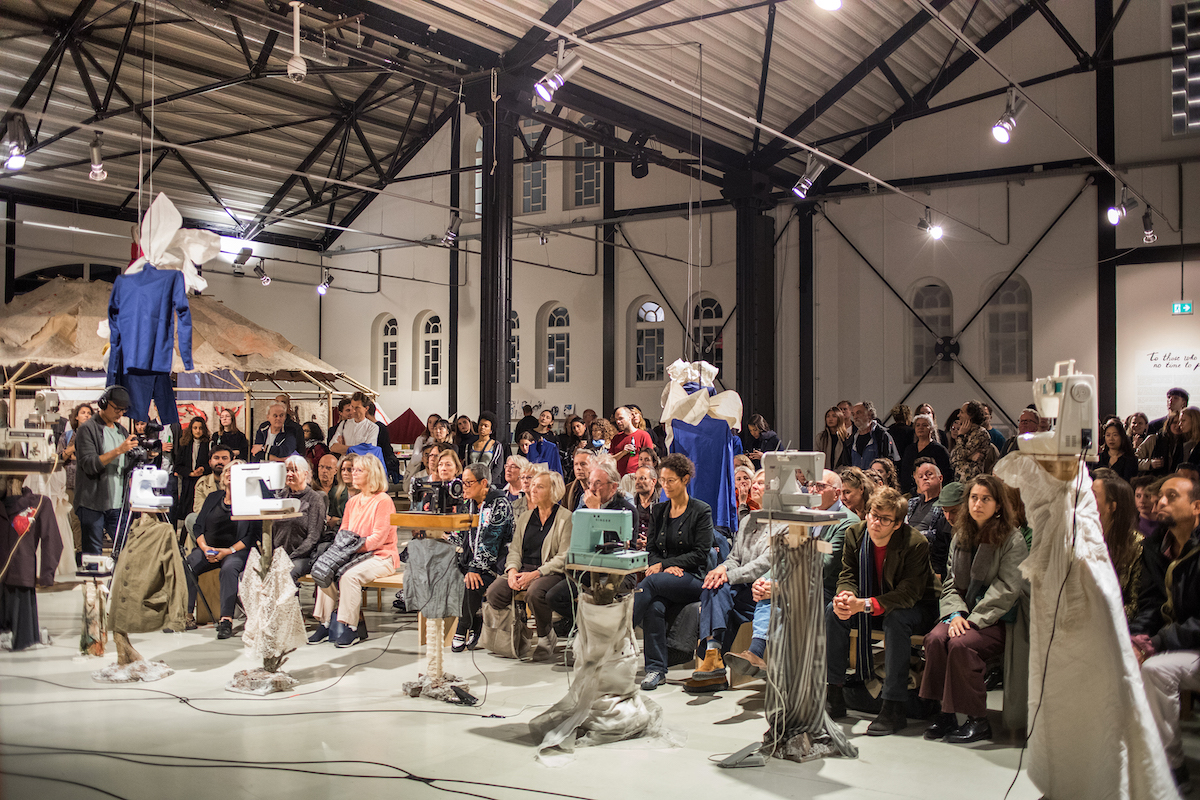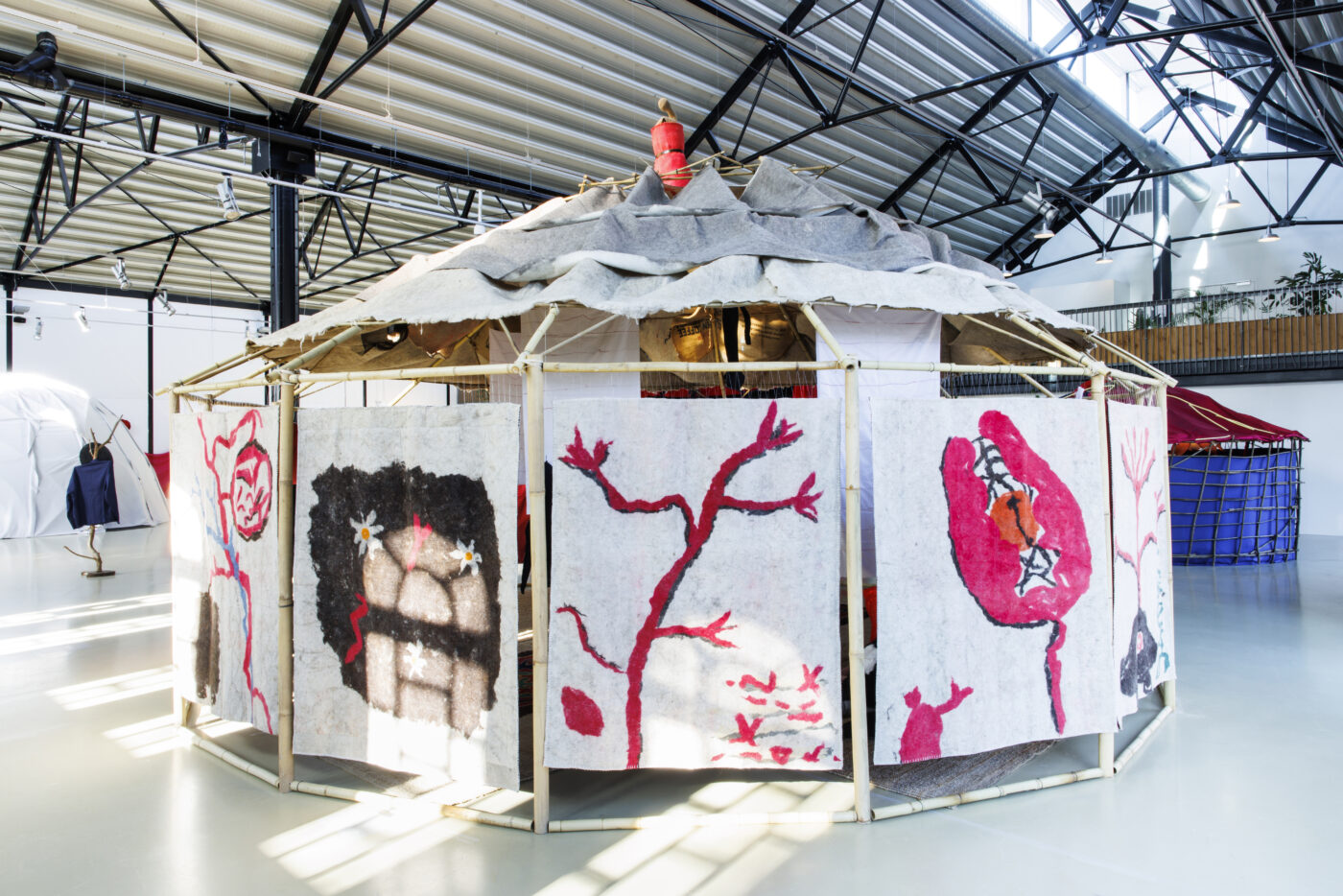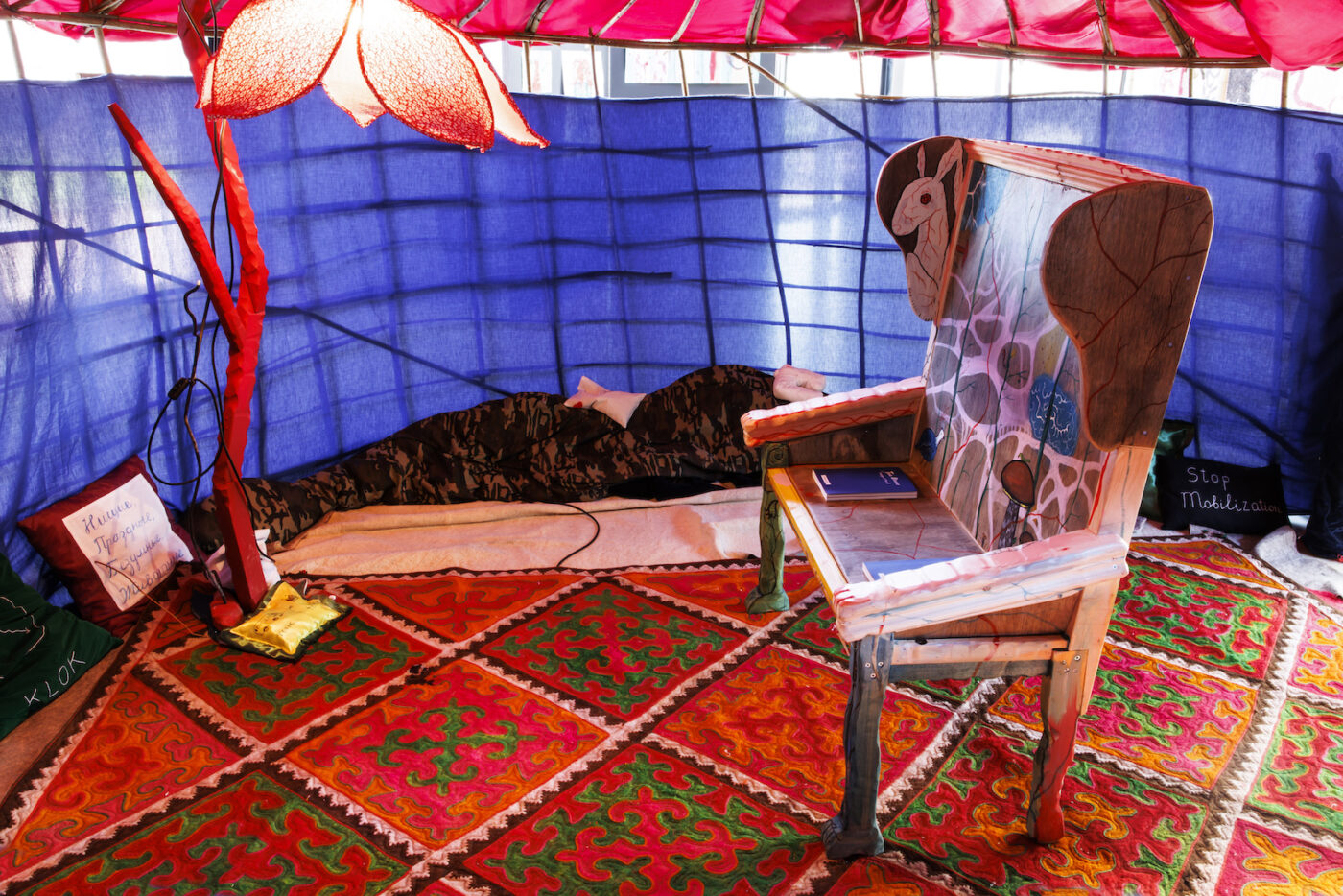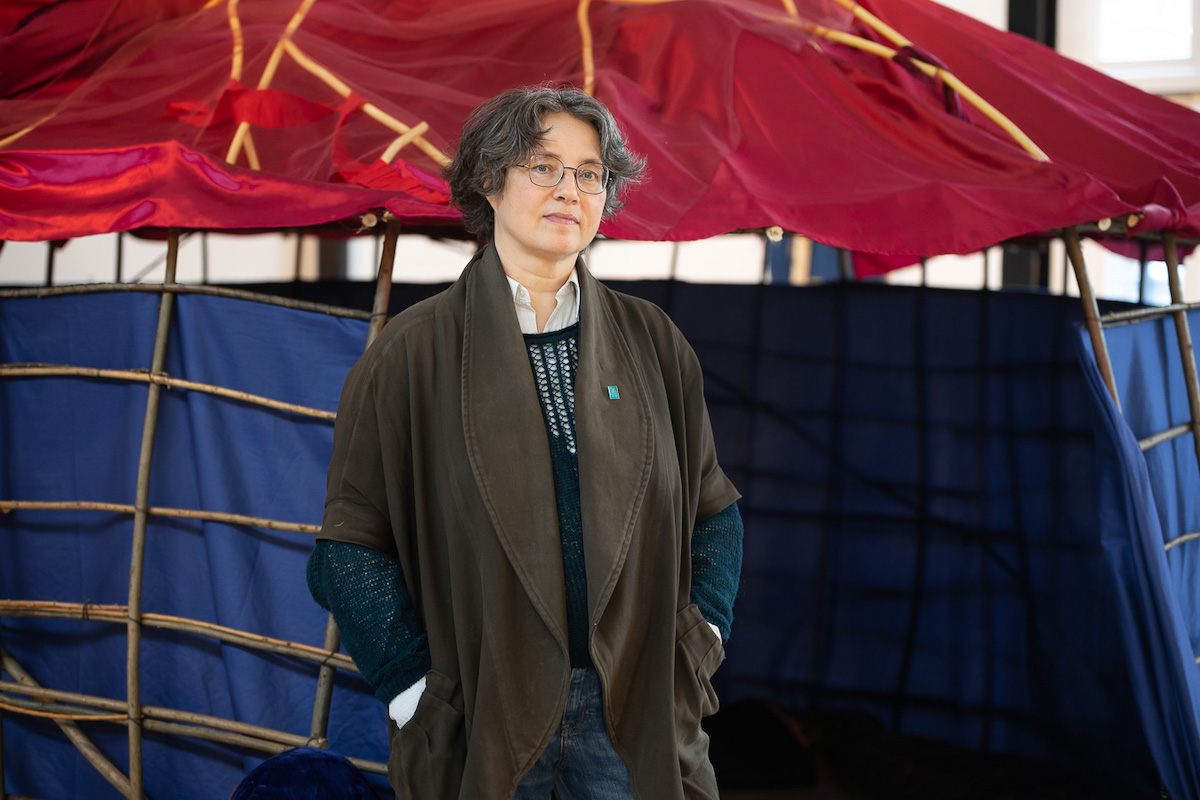'To those who can imagine' by Anna Bitkina
The first major solo exhibition by artist Gluklya To those who have no time to play commissioned by Framer Framed and curated by Charles Esche comprises a solid body of new works developed by the artist throughout the last five years. The exhibition unites different parts of Gluklya’s past and ongoing artistic research on global and regional outcomes of accelerated capitalism, repressive political regimes, different forms of coloniality and post-colonial conditions, which she investigates in the European Union and its former colonies, in today’s Russia and in countries that were once a part of the Russian Empire and the Soviet Union. This essay intends to serve as a non-linear alternative guide through the exhibition’s contexts and experiences with some references to Gluklya’s projects that anticipated and informed the exhibition at Framer Framed.
Text by Anna Bitkina
Looking Beyond Reality
A long awaited exhibition To those who have no time to play (2022-2023) came into sight in Amsterdam in the midst of a very uneasy moment of contemporary political history when the wrestling between the world powers driven by imperialism has broken out in the centre of Europe (again). Composed as an imaginary living environment with elements of vernacular architecture, the logic of Gluklya‘s exhibition resists global world collapse by juxtaposing it with the potentiality of interpersonal kinship and interspecies exchange. Constructed with care, her world demonstrates multifunctional purposes and the social role of art under capitalism and in the situation of growing political suppression and escalating militarisation. Being an outstanding example of creativity and ingenuity the exhibition serves as a public forum for gatherings to provide trans-regional and trans-personal exchange on common political and ecological history and economic interdependency. Gluklya’s generous and diverse visual language wishes to feel in the emotional void in the time of local and global human segregation caused by wars, racial superiority, social and economic privileges, ideological suspicion even among like-minded people, unresolved historical traumas and contested worldviews, bodily fears, psychological barriers and biological conditions.
Strongly believing that private life is inextricably linked to political processes Gluklya follows her artistic principle to be on the side of those whose lives are most vulnerable and defenceless. She often contrasts the language of governmental and militant power with the positions of unprotected individuals without political voices who are abused by these structures, underclassed and labelled within social stratasstrata. Fragile lives of individuals whose bodily and physiological states are affected by the political system are at the centre of Gluklya’s creative stories. What exists as a steady state order in the public domain in Gluklya’s exhibition becomes inherently private and manifests as ongoing and “normalised” violence and injustice embedded into different social and power structures. Through her practice Gluklya strives to build channels of interclass engagement to renegotiate the processes that shape contemporary conditions and divisions. Gluklya opts to disrupt the apparent normality of reality and to propose alternative support structures and means for communication.
Scaffolding the Future
In To those who have no time to play we find several narratives of individual and collective protest against oppressive institutions of powers. The exhibition could be imagined as interconnected layers and superpositions of different personal stories by individuals with intersectional identities as well as beddings of local and global political processes and times. It’s a journey through the bodies and minds of creative visionaries that have much in common but might never have met if not in Gluklya’s exhibition which interweaves their lives to stress the significant meaning of the collective and polyphonic voices.
Through her visual and performative language, Gluklya creates a so-called “visionary fiction”, a method proposed by Walidah Imarisha, an American writer, activist, educator and spoken word artist whose practice is rooted in the social change movements. Walidah Imarisha advocates for a form of “fantastical art that helps us to understand and challenge existing power structures and supports us in imagining paths to dreaming and creating more just worlds”.[1] She stresses, “We cannot build what we can’t imagine or see. We should remember to imagine and scaffold the future.” Therefore, Gluklya’s exhibition serves also as a “laboratory of radical imagination” where different geographical locations, political realities, and communities are interconnected.
In order to understand the mechanism and the logic of To those who have no time to play we should try to play with it and deconstruct, as much as curious kids who dismantle toys to check what is inside. Keeping this in mind, we can start looking at different layers of the exhibition body and to dissect it part by part. It should be mentioned that Gluklya initially designed the exhibition as an anatomical experience consisting of structures in the shape of internal human organs – heart, lungs, brain that are connected through long red arteries. We still see some remnants of this artistic vision in the show but in a modified way.
The Stage
The first layer of To those who have no time to play is very architectural, therefore, to have a closer look at the exhibition landscape will require to the viewer the optic of the architect. What stands out first is the two-level stage topped with the red velour canopy. The stage is given to the main characters, supposedly, alive and dead bodies, of “Antigone Update”, a new version of Sophocles’ “Antigone”, a classical Greek tragedy that forms a genesis for Eurocentric norms, principles of democracy and logic of justice. Sophocles’ “Antigone” is considered a “must read” literary piece in European education that is focused on the eternal struggle between state power and personal (political) will. Being influenced by different readings and studies of “Antigone”, including the scholar of feminist democratic theory Bonnie Honig, Gluklya questions the notion of power and subverts the idea of individual heroism, love, female solidarity and “forms of corporeal care”. Gluklya’s version of “Antigone” has a potential for legislative imagination which undermines the letter of the rational law and focuses on an alternative set of rights that are more responsive to personal needs, emotions, and beliefs.
All “alive” protagonists of the play are materialised as standing at the stage costumes with elements of their characteristics: militant figure of Creon; thin, curving and submissive his wife Eurydice; well-behaved but traumatised and with a big hole, their son Haemon; emotional and in pain Antigone in a dress also full of holes; doubtful, law-abiding and pierced with the net of blood arteries her sister Ismene; frightened as a bird Messenger; torn by contradictions and doubts Sentry, wise Tiresias accompanied by a little boy. The body of dead Polynices is also given the agency by being placed at the lower level of the stage, in a niche of another world. To dramatise the antagonism and tension between Antigone and Creon, Gluklya has framed the stage with two red costumes: a ragged screaming in despair wooden mask of Creon and a dark dramatic flower of Antigone, the personification of two forces: a man who make the laws and a woman who does what she feels is right. The question of what is right is central to “Antigone Update”.

Photo by Eva Broekema / Framer Framed
The architectural structure of the stage is composed as an imaginary microsociety and accompanied by a cohort of humanised sewing machines, which, on the one hand, acts as a collective social majority (the chorus, in the tradition of the Ancient Greek tragedy), and on the other, plays a utilitarian symbolic function, namely, they sew together all the exhibition narratives. The chorus is represented by the costumed characters and figures of different age, gender, social class and emotional intensity. Textile and clothes are one of the main mediums and materials in Glyklya’s practice which she describes as an invented language: “For me working with textile is being alive and speaking with myself and the world via non-verbalised surrogate of different desires.”[2] The machines are accompanied by various biomorphic creatures, produced in collaboration with textile artist Natalia Grezina, that are placed throughout the exhibition space – sonic Narcissus flowers dressed in blue work jackets found in Amsterdam vintage shops and tree branches merged with sweatshirts and attached books.
The plot of Sophocles’ “Antigone” and its contemporary interpretation is a focal and connecting infrastructure for the exhibition that has been chosen in a search for an abstract and universal form to reflect on the current tragedy. In the light of the growing political and military trans-regional antagonism imposed by Russia in Ukraine, the moral choice between the state order and personal ties confronts millions of individuals with excruciating decisions to take sides which tear apart family members, beloved ones and friends unions.
Three other architectural structures of the exhibition are designed as temporal micro-universes with their unique cosmologies.
House of Female Imagination
One of them takes form of a Central Asian yurt (“боз үй” in Kyrgyz) which Gluklya turns from a traditionally regulated environment with a strict division of areas for women and men into a house of female imagination and care, a domain of listening and storytelling, a place of mastering craft.[3] Artist and architect Benjamin Roth, who constructed the yurt, kept in its design the main traditional elements. For instance, he has built the top of the yurt (tyundyuk), which is perceived as a unifying beginning in Kyrgyz culture. At the exhibition it is symbolically marked by the red dress with raised hand – a sign of liberation and freedom that has appeared across Gluklya’s projects for many years.
The nomadic home of the yurt has been set up in Framer Framed as a shelter to accommodate the life stories of Kyrgyz seamstresses Dinara, Rakhat, Zaina and Samira who work intensively in the clothing industry and have no time to play with their kids (hence the title of the show). They struggle from an ongoing bodily and mental violence caused by the harsh labour and poor ecological conditions of the industry as well as from sexual abuse embedded in working environments and domestic lives of many Kyrgyz households. Their stories manifest the post-Soviet colonial conditions and the consequences of regional capitalism by addressing the economy of Kyrgyzstan where the ‘slavery’ textile industry forms a major part of the country’s budget. Almost all clothing produced in Kyrgyzstan is exported to Russia and Kazakhstan to provide low-income segments of the population in these countries with cheap clothes.”[4]
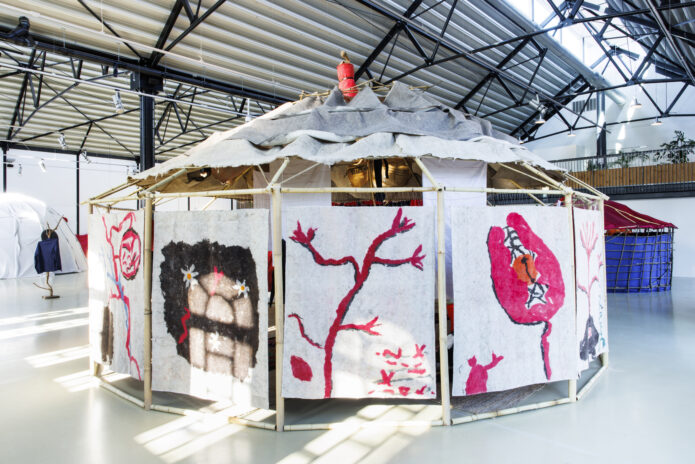
Photo by Eva Broekema / Framer Framed
The video playing inside the yurt, titled Gulmira’s Fairy Tales and performed by Kyrgyz actress Gulmira Tursunbaeva, could be interpreted as a collective historical and contemporary female voice of Kyrgyzstan. The video narratives include part of biographies and dream fragments of Dinara, Rakhat, Zaina, Samira collected by Gluklya through a number of personal encounters with the seamstresses during her trip to Bishkek. Disrupting their automated and zombified 15-17 hours daily working routine, Gluklya conducted with them a series of listening and creative sessions in an attempt to make space in their minds and working schedule for play and imagination. The results of these collective creations are presented in the yurt in the form of zoomorphic textile and angel-like creatures.
Weaving personal stories into the overall political fabric and presenting them using popular media formats is a continuous artistic method of Gluklya, which she practises in her durational performative project Debates on Division. When Private Becomes Public (2014-2019). The presentation format of Gulmira’s Fairy Tales resembles a regular TV show for kids Good Night, Little Ones! (in Russian “Cпокойной ночи, малыши!”), which from the 60s until now is one of the most known and popular shows for kids among Russian speaking people of several generations and an integral part of Soviet identity. In the series of fairy tales “Blue Rabbit”, “Tango of My Grandmother”, “Ghost” and “Revenge”, Gluklya carefully combines the contemporary biographies of her heroines and historical memories. The archival records of female emancipation in Central Asia under USSR were collected by Gluklya in Moscow and Bishkek with the help of researcher and artist Katya Ivanova.
As in many of her works in To those who have no time to play Gluklya demonstrates not the external, but the internal freedom and strength of her characters. Through the visual tales that contain elements of humour, absurd and grotesque, she endows her heroines with a political voice, incredible will power, creativity and imagination by building a continuity of herstory through time, geographies and suppressive political ideologies. By giving “Gulmira’s Fairy Tales” the subtitle “TV for Seamstresses” Gluklya foresees a potentiality for this fairy tale series to become a common platform for conversations, exchanges and unity for the female working class to grow its power and rights.
The yurt is covered and framed with 16 prints, mats and carpets made from traditional woollen felt. To produce them, Gluklya collaborated with local craftswomen from Felt Art Studio (Issyk-Kul) that specialise in this felt pattern rolling technique. The felt prints depict different drawings by Gluklya that build associative links with the lives of the Kyrgyz seamstresses and their invisible hard labour: body parts like lungs and ribs that are merged with the sewing machine which the women spend most of their time at, the inner ear as a symbol of listening, the clock – endless working time or lifetime stolen by capitalism.
Chapel of Friendship and Affinity
The yurt neighbours another structure that could be called My Swollen-Hearted Friend, which materialises some aspects of Gluklya’s ongoing research on migration, displacement, cross-cultural misunderstandings and a search for a common language of care and hospitality.[5] Its textile top looks like a heart with cut red arteries and blue veins. This space embraces the story of a Kurdish political activist and writer Murad Zorava, presented at the exhibition through elements of design and a book project Two Diaries – a published exchange of parallel diaries written by Gluklya and Murad.
Murad and Gluklya met at the former prison Bijlmerbajes in Amsterdam where Murad was a resident of the asylum seekers’ centre (AZC) organised there in 2017. Following an open call by Lola Lik, Gluklya was offered to rent a studio at one of the prison towers together with other artists and creatives. It has since become apparent that this pop-up creative cluster was part of a major gentrification project and the masterplan The Bajes Kwartier of OMA, the Office for Metropolitan Architecture founded by Rem Koolhaas and Elia Zenghelis in 1975..
Through their diaries, we learn about the growing friendship and personal stories of the authors as well as their traumatic encounters with the state migration policy and business schemes that were cynically intertwined. Although, as Murad writes “the outlines of my life story are shared by tens of thousands of people in my country.”[6] He was imprisoned for his political views, actions and for just being Kurdish. He had to flee his country due to constant political persecution to find a home in the Netherlands. Gluklya proposed Murad to keep a diary “as a healing and exhaling” process, the practice that she started earlier to overcome the strict policies in Bijlmerbajes. The writing exercise was also for both a method for better understanding of each other’s inner worlds and an exchange of their experiences being residents of Bijlmerbajes, although in different statuses.
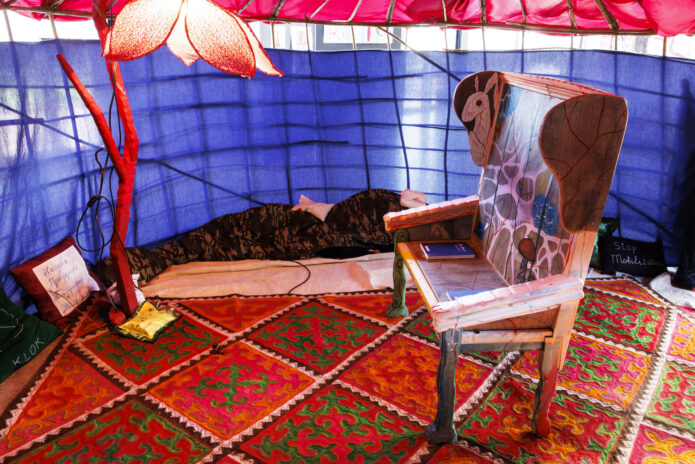
Photo by Eva Broekema / Framer Framed
The architecture of this ‘chapel of friendship and affinity’ has some references to the neighbouring yurt, however, it differs with a more personalised and intimate touch and the energy that resembles a place of solitude. The floor covered with felt carpets is encircled with many pillows of different forms that correspond with the Central Asian or Turkic tradition. Containing thematic embroidery and texts these pillows are dedicated to Murad, who suffered at the AZC in Bijlmerbajes without pillows that were forgotten to be put in his room. The lack of pillows has haunted him from previous imprisonment nightmares. The interior of the chapel consists of a bench or the ‘chair for two’ produced by Roger Cremers and a standing lamp in the shape of a lily flower with the stem of a human spine. Standing in the centre of the space, they are designed to invite the exhibition visitors to experience the collective writing of Gluklya and Murad. Another symbol of unity is a drawing of human lungs on the bench back. On the one hand, it is a metaphor of “writing in one breath”, and on another, it transmits the shared breathing conditions of Gluklya and Murad at Bijlmerbajes where it was impossible to open the windows in the buildings.
The publication Two Diaries has a distinct element of an artist drawing book that includes 64 over 40 of Gluklya’s drawings and watercolours which she drew while being a resident of Bijlmerbajes. They could be divided into three sections of drawings that are dedicated to several activities – the images that came out during the Language of Fragility workshops with asylum seekers, sketches of characters and costumes for the Carnival of Oppresed Feelings and different emotional states of Gluklya with which she is haunted during the time of her residency in the former prison building. The themes of Gluklya’s drawings are often associated with animal-vegetative themes, sensuality, empathy and caring in which she practises the connections between political imagination and ongoing events with existential states that leave traces in the subconscious. The set of emotions that Gluklya transmits through colourful or very dark images in Two Diaries gives different dimensions to the book by captivating the inseparable unity of the body, words, plants, elements of architecture and fantastic clothes. Some of the original drawings from the book can be seen at the exhibition space around the chapel.
Madhouse
Finally, a structure in the form of a white dome, titled Melting Snowball, serves as a screening space for the documentary chronicle of the May 1st demonstrations in St. Petersburg recorded by Gluklya and her comrades in 2017, 2018 and 2019. The installation “Melting Snowball” questions how to regain the future and get back what was lost or taken. The video documentation of the May 1st demonstrations in St. Petersburg not only guides through the recent alternative political history in Russia but also intends to look at what has anticipated this period of social life and speculate about what is next.
Being totally appropriated by governmental ideology during Soviet time, straight after the collapse of the Soviet Union in Russia, May 1st got its revival and regained its political meaning by becoming a gathering place for all possible political denominations from ultra-right nationalists, communists and anarchists to democrats and ultra-left including vegetarians, progressive critical thinkers and contemporary artists and performers with sharp and provocative banners. To contextualise Gluklya’s video and recall the emergence of citizenship in post-Soviet Russia, it would be pertinent to bring attention to the film by Ukrainian filmmaker Sergei Loznitsa The Event (2015) in which he revisits the dramatic moments of August 1991 known as Putsch that led to the collapse of the USSR. “In the city of Leningrad thousands of confused, scared, excited and desperate people poured into the streets to become a part of the event, which was supposed to change their destiny.”[7] A quarter of a century later, Sergei Loznitsa revisits the dramatic event by editing the archival footage that documents the life of the city at the time of a historical calamity and, possibly, the birth of something new. In The Event we can see how ordinary life turns into history; people’s faces, singular close-ups taken in the time, which cannot be found in history textbooks or transcripts of political speeches.”[8]
For the last 20 years, Russian civil society has been pragmatically and persistently dismantled through a series of legislative and power apparatuses engineered by Putin and his collaborators. The courage of the ongoing protests now and then is useful to juxtapose with the series of laws implemented in Russia during this period aimed at the severe punishment of any manifestation of citizenship, human rights and free thoughts. It would be also fair to mention that during this period, a layer of grassroots initiatives (cultural, academic, social) has grown and formed in Russia, which actively sought to create and popularise democratic principles and promote the basics of political literacy and critical thinking.

Gluklya, May 1st (2017-2019), film still (2022)
In her lengthy video Gluklya captures the last years of the May 1st demonstration before it faded out completely due to years of COVID-19 when public events were forbidden. The pandemic factor “conveniently” overlapped with the persistent and years-long agenda of Putin’s regime to disintegrate and demolish all possible political forces and alternative critical thinking in the country.
Intuitively imagining that May 1st is an important event to document as an image of Russia’s collective political life, Gluklya could barely have envisioned that this footage would become an important time document. Similar to the explicitly political film essays by Harum Farocki, in her video Gluklya uses the genre of ‘direct cinema’, by including in the video frame different participants of the events and keeping her point of view rarely revealed. Through this video recording of a relatively short period of political history we can observe the brewing features of the authoritarian regime, the peak of which we are seeing in today’s Russia. From year to year in the video we observe the growing control of public space and censorship of slogans.
Together with her friends and collaborators Gluklya also forms her own ‘Column of Fragility’ with costumes and slogans that aims at queering the vertical of power and addressing different pressing political inquiries. Examples of some of the costumes that formed the protests’ visuality are presented at Framer Framed outside of the screening dome. This line of ‘conceptual sticks’ includes protest art clothes that were produced for other demonstrations and performative actions across different years. One of them being Gluklya’s significant work that anticipated this installation: Clothes for the Demonstration Against False Election of Vladimir Putin (2011-2015), developed during the series of protests For Fair Elections in Russia between 2011-2013 and which some English language media referred to as the ‘Snow Revolution’. Presented at the 56th Venice Biennale in 2015, the 43 objects ‘re-created’ representatives of protesters with different political positions.

Gluklya, Demonstration Against False Election of Vladimir Putin. Installation at the 56 Venice Biennale (2015), mix textile, wood, hand writing
In the video, philosopher Oxana Timofeeva says during the 2018 demonstration that “only being on the verge of madness wecan understand the essence of things”. Watching the documentation of these demonstrations from the present when Putin’s regime has entered its highest level of madness, we understand that this agony with the last convulsions of Soviet imperialism cannot last forever. As they say, the end comes unnoticed. This reminds one of Alexey Urchak’s famous book “Everything Was Forever, Until It Was No More” about the paradoxes of the Soviet political project that were revealed by the peculiar experience of its collapse. Possibly after the end of the current totalitarianism in Russia, Gluklya’s video documentation of the May 1st demonstration in St Petersburg will serve as a historical record documenting the last years of Russia’s ill and decomposing political regime.
The exhibition To those who have no time to play finds its stage in Framer Framed, an institution that for many years has been a platform to rethink the role of art, and the position and purpose of art institutions in the cultural and political life of civil society. Since 2008, Framer Framed has provided possibilities for nurturing and developing different communities. The institution operates as a living organism of connections, exchanges, different cultures and learning approaches, visions and positions. It seems like there could not have been a better place to present Gluklya’s show which by nature is not a stable, finished and rigid structure. It’s not finalised. Even after the opening it’s in a process of adjusting, polishing, editing and growing into something new.
A version of this text has also been published in two parts by NERO Editions: To Those Who Can Imagine and New Communities of Care.

Photo by Eva Broekema / Framer Framed
1 Symposium “No Linear F*cking Time” at BAK basis voor actuele kunst, session Toward the Not-Yet: Art as Public Practice, May, 2022, presentation by Walidah Imarisha: https://www.youtube.com/watch?v=3Ilv_HsztTg.
2 Two Diaries: Gluklya and Murad, 2022, page 79
3 “Inside yurt is a very regulated area with clear division of the space: to the left of the entrance there is the world of men, the right is the female half. The central part is the hearth, behind which is t a place for guests of honour. During the wedding, the engaged bride is seated on the male half, she no longer belongs to this family, she is like a guest. In the same way, during the funeral the deceased body is placed on the same part, the dead person is associated with the guest, which, like the bride, leaves the world of the family”. From the correspondence and consultancy with Inga Srasevich, Senior Research Fellow, Department of Central Asia Ethnology, Peter the Great Museum of Anthropology and Ethnography (Kunstkamera), St. Petersburg.
4 Based on the article Kyrgyz Sewing Slavery by Kyrgyzsoc, 2020 (available in Russian): https://kyrgsoc.org/kyrgyzskoe-shvejnoe-rabstvo/?fbclid=IwAR0Evi52tjtMZOHkNWyY7awktxCZ0F0dO8Muwj7NCpUhBjqpeTNYM1MdwF8.
5 Two Diaries: Gluklya and Murad, 2022, page 144.
6 Ibid, p. 146.
7 https://europeanfilmawards.eu/en_EN/film/the-event.4325
8 Ibid, Sergei Loznitsa’s statement.
- NERO Editions - 'New Communities of Care' by Anna Bitkina
- NERO Editions - 'To Those Who Can Imagine' by Anna Bitkina
- Personal website of Gluklya
Links
Curatorial Text / Feminism / Art and Activism / Performance / Textile /
Exhibitions

Exhibition: To those who have no time to play
A Solo Exhibition by Gluklya
Agenda
Finissage: To those who have no time to play
Live performance of 'Antigone Update' and discussion
Network
Murad Zorava
Activist
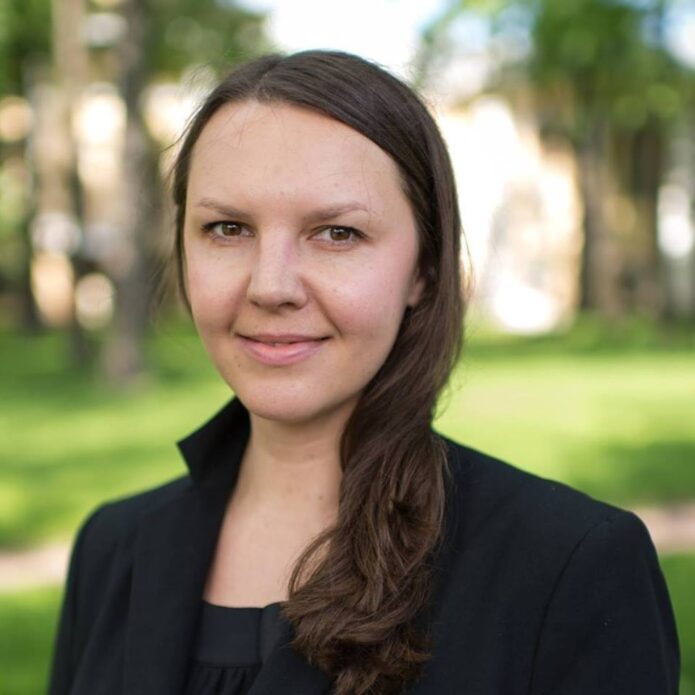
Anna Bitkina
Curator and writer

